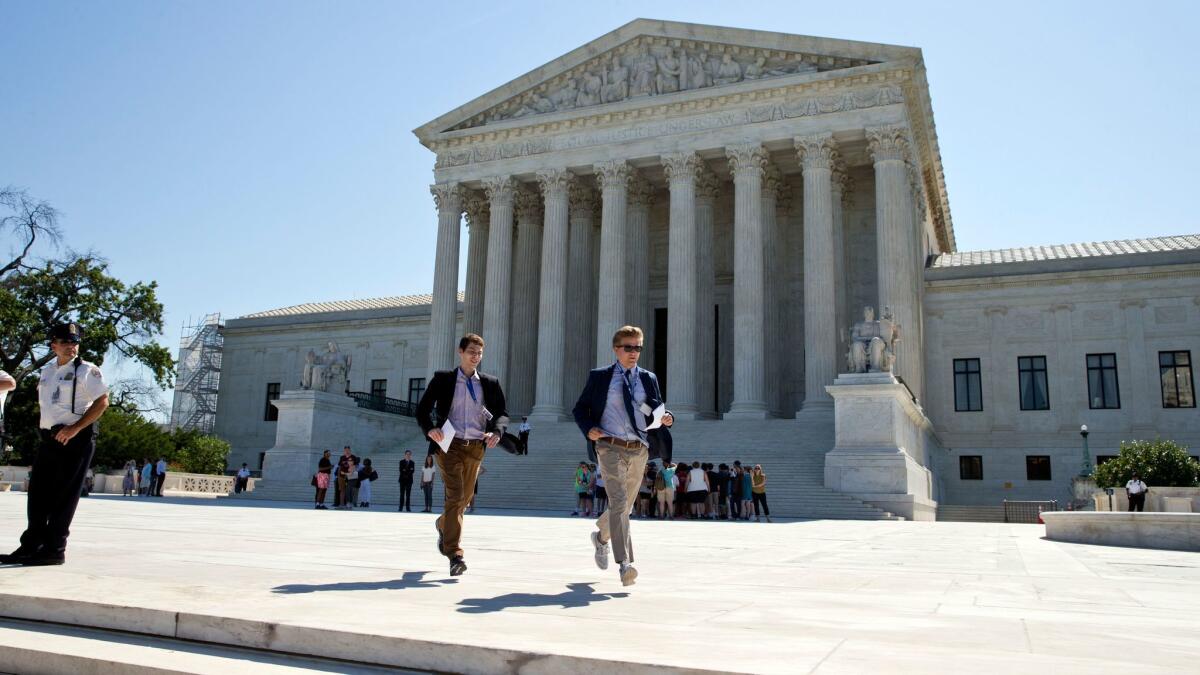Op-Ed: It’s the Supreme Court, not the Senate, that needs to do its job right now

- Share via
The U.S. Supreme Court released its December calendar of oral arguments last week. Normally, the justices hear 12 or more cases during this sitting, but this year, they have scheduled only eight — a calendar court commentators have called “bare-boned” and “anemic.”
In addition, the Court has not yet scheduled oral arguments in three important and controversial cases involving the separation of church and state, property rights and class action lawsuits. All three cases were accepted by the court before Justice Antonin Scalia’s death in February. Speculation from Amy Howe at SCOTUS Blog is that Scalia had voted to grant review, and that the court — still lacking his replacement — is stalling to avoid a 4-4 tie. Other observers also believe the court is taking fewer controversial and important cases for review than in previous years.
The fact that there are eight justices does not mean they shouldn’t hear and decide cases like they normally do.
There’s some evidence that the court has changed its behavior because it has only eight justices. Justice Sonia Sotomayor has said publicly, “It’s much more difficult for us to do our job if we are not what we’re intended to be — a court of nine.” Justice Ruth Bader Ginsburg has opined an eight-person court is “not good enough” to decide difficult and controversial cases such as the immigration and public union fee cases the justices divided 4-4 on last term. “When we are evenly divided, it is equivalent to denying review,” Ginsburg said. On the other hand, Justice Stephen Breyer recently remarked that, even with eight Justices, the Court’s “mechanics work about the same.”
On Twitter, court scholar Laurence Tribe agreed that the Supreme Court was deliberately moving slowly because of its vacant seat, although he doesn’t believe it’s doing so to send a message to the Senate. Still, the light calendar and delay in those three big cases have led to renewed calls for the Senate to “do its job” and hold hearings on Merrick Garland’s nomination.
Leaving aside the Senate’s intransigence, the Supreme Court needs to just do its job and return to business as usual.
The fact that there are eight justices does not mean they shouldn’t hear and decide cases like they normally do. Sotomayor’s statement that the court is “intended to be nine” is hardly convincing. The court began with six justices, but expanded to nine in 1837. It also, for a few years, from 1863 to 1866, even had 10. In any event, the constitution gives Congress the job of deciding the size and jurisdiction of the Supreme Court.
The court may be stuck at eight for a while if the Republicans hold on to the Senate in the November election. Sens. John McCain (R-Ariz.) and Mike Lee (R-Utah) have been hinting that the GOP will resist not just Garland, but also any nominee put forward by Hillary Clinton. So if the members of the court really feel they can’t uphold their constitutional duty when they are short one justice, they need to say something publicly as an institution.
Concern by the justices that speaking out may look too political is silly. The court finds itself in this stalemate because it is primarily a political institution to begin with. And, as the third branch of the national government, the court has a right to protect itself.
Most importantly, the court should not change its practices because it is missing a ninth justice. If a worthy case needs deciding at the national level, the justices should resolve the controversy and give lower courts and the people a final answer. If five out of the eight justices cannot reach agreement, then maybe a national rule is unnecessary.
In every Supreme Court case, after all, the underlying question is always the same: Should a majority of nine (or now eight) justices impose their view of the law on the states, the Congress, the president, the American people and sometimes all of the above? If the only way they can reach such decisions is through partisan agreement by a majority of justices, then maybe they shouldn’t rule on that case in the first place.
In any event, being down a justice is no excuse for the court to shirk its constitutional duties.
Eric J. Segall, a law professor at Georgia State University, is the author of “Supreme Myths: Why the Supreme Court Is Not a Court and Its Justices Are Not Judges.” Twitter: @espinsegall.
Follow the Opinion section on Twitter @latimesopinion and Facebook
More to Read
A cure for the common opinion
Get thought-provoking perspectives with our weekly newsletter.
You may occasionally receive promotional content from the Los Angeles Times.










